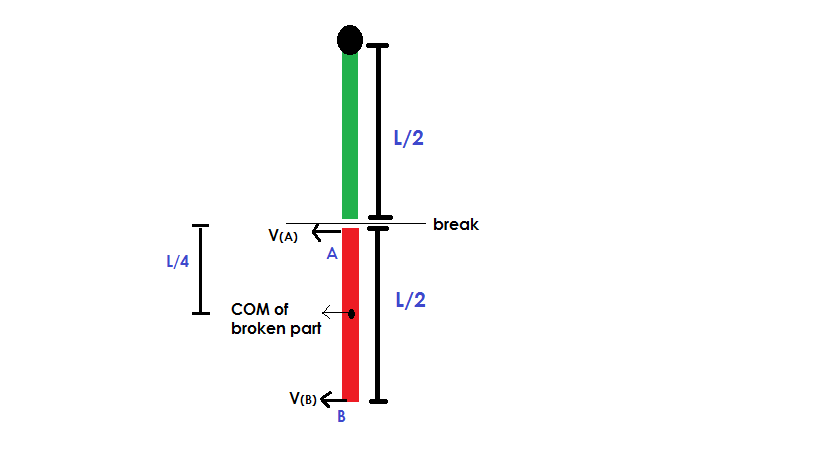Breaking Rod
A uniform rod of length is hinged at one of its ends and is free to rotate. The rod is initially at rest and horizontal, and is now released. The moment it becomes vertical, it is broken at its midpoint and its lower part now moves freely.
Calculate the distance of the center of the lower part from the hinge when rotating through
Details and Assumptions:
- The lower part of the rod is no longer attached to the top half, and its motion is unaffected by the process of separation from the top half.
- Give your answer in meters to two decimal places.
- Take
The answer is 2.52.
This section requires Javascript.
You are seeing this because something didn't load right. We suggest you, (a) try
refreshing the page, (b) enabling javascript if it is disabled on your browser and,
finally, (c)
loading the
non-javascript version of this page
. We're sorry about the hassle.
Relevant Wiki : rotational kinetic energy - conservation of energy
The first part of the problem says that the rod is released from horizontal position and rotates in vertical plane by an angle 9 0 ∘ . Let the angular velocity of rod about the hinge be ω . Firstly lets find out the angular velocity of the rod: Applying conservation of energy,
2
m
g
l
I
=
3
m
l
2
⇒
ω
=
2
1
I
ω
2
=
l
3
g
(
1
)
Now the question says that as soon as the rod becomes vertical it breaks from its midpoint and there is no effect on the motion of any part of rod during the process of separation.
So now we consider the lower part of the rod as a separate body and study its motion.
Applying conservation of energy,
2
m
g
l
I
=
3
m
l
2
⇒
ω
=
2
1
I
ω
2
=
l
3
g
(
1
)
Now the question says that as soon as the rod becomes vertical it breaks from its midpoint and there is no effect on the motion of any part of rod during the process of separation.
So now we consider the lower part of the rod as a separate body and study its motion.
 The center of mass of the lower rod is at a distance of
4
3
l
from the hinge. Let
ω
0
be the angular velocity of the rod about its new centre of mass. We can write velocity of center of mass of lower rod as :
v
c
o
m
ω
0
v
A
=
2
ω
l
⇒
ω
0
=
ω
×
4
3
l
=
A
B
v
B
−
v
A
A
B
=
2
l
=
ω
v
B
=
ω
l
(
2
)
The motion of lower rod after separation will be combination of translation motion and rotation motion about its center of mass. The angular velocity of the lower rod will remain unchanged during subsequent motion because no torque acts on it (The weight of the rod acts about it center of mass and hence passes through the axis of rotation and hence produces no torque). The lower rod will become vertical again after it rotates by an angle
1
8
0
∘
about its axis (passing through center of mass and perpendicular to the rod). Hence time taken by rod to rotate by
1
8
0
∘
is:
The center of mass of the lower rod is at a distance of
4
3
l
from the hinge. Let
ω
0
be the angular velocity of the rod about its new centre of mass. We can write velocity of center of mass of lower rod as :
v
c
o
m
ω
0
v
A
=
2
ω
l
⇒
ω
0
=
ω
×
4
3
l
=
A
B
v
B
−
v
A
A
B
=
2
l
=
ω
v
B
=
ω
l
(
2
)
The motion of lower rod after separation will be combination of translation motion and rotation motion about its center of mass. The angular velocity of the lower rod will remain unchanged during subsequent motion because no torque acts on it (The weight of the rod acts about it center of mass and hence passes through the axis of rotation and hence produces no torque). The lower rod will become vertical again after it rotates by an angle
1
8
0
∘
about its axis (passing through center of mass and perpendicular to the rod). Hence time taken by rod to rotate by
1
8
0
∘
is:
t = ω 0 π Using equation of motion we calculate the horizontal and vertical displacement of the com of lower rod : y x = 2 1 g t 2 = v c o m t Hence distance of the center of lower rod from the hinge (d) is given by: d = x 2 + ( y + 4 3 l ) 2 Substituting the values of given variables in SI units, you get: ω v c o m t x y d = 6 . 3 2 4 rad s − 1 = 3 . 5 5 7 m s − 1 = 0 . 4 9 6 s = 1 . 7 6 7 m = 1 . 2 3 3 m = 2 . 5 1 9 m